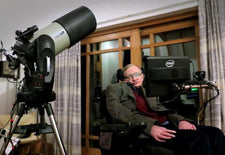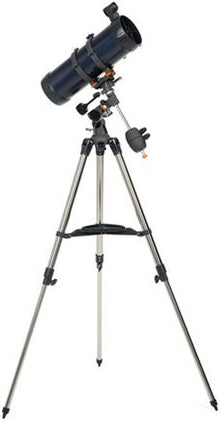Using an Automatic GoTo Telescope
May 4, 2015
Welcome to the future. The future, that is, of automatic astrolocation. There's something rather magical about a telescope that can automatically locate objects for you, and that magic is more available than ever to beginning and amateur astronomers. With an automatic GoTo telescope, just set the system to "Orion Nebula," and you'll be viewing it in all its jaw-dropping glory in seconds. After taking in the photons of light that have traveled light-years to reach your eye, swing over to view Jupiter (or anything else) with a simple push of a button.
 |
The automatic GoTo telescope is an amazingly simple thing to use and is available from many telescope manufacturers. You'll find mostly the same technology on telescopes costing three hundred dollars or three thousand dollars, but every brand does it just a little differently. What follows is a basic guide on how to set up, align, and enjoy your automatic GoTo telescope, regardless of make or model. So how do these automatic telescopes work? How do they know where to point to show you something so amazingly far away centered perfectly in your telescope's field of view? Every automatic GoTo telescope functions with the same basic principle. They're pre-programmed with an incredibly detailed map of the sky and the objects it holds, but they need to be "aligned" to the night sky to create a reference point from which all objects can be found. |
The GoTo telescope system starts with the most basic of information - location, date, and time. Most GoTo telescopes simply want the name of a nearby city chosen from a database. Some will want your latitude/longitude data. The date and time tell the telescope what objects are visible when and where you are. GPS-equipped GoTo telescopes take data collection to the next level, using their connectivity to enter location, date, and time for you.
With the correct location, date, and time, your GoTo telescope has a pretty good idea of where it is. But it's not quite ready to reveal the wonders of space to you yet. You'll need to provide the telescope with a little more information so it knows exactly where it, and everything else, is. This is the Telescope Alignment Process.
Telescope Star Alignment Process
With your GoTo telescope outside, aware of its location and the current date and time, you're ready to begin alignment. Each major manufacturer has a slightly different method, but they all share the same basic principle. In order to find objects, the telescope needs some reference points. The perfect reference is exactly why you're outside with a telescope in the first place - the stars! You telescope will need to be first pointed at a known star, which can be centered in the eyepiece of the telescope and selected in the built-in database. You'll usually be asked to repeat this once or more on selected star(s). Now that the telescope has two reference points in the night sky, its internal computer can calculate the exact location of thousands of objects - all ready for you to view by pressing a button. Again, welcome to the future.
Telescope Alignment and Different Manufacturers
Every major brand of automatic telescope uses the same basic alignment process - location, date, time and alignment stars. But, of course, they're all a little bit different from each other. Getting to each step will vary slightly between manufacturers and even telescope series. Our telescopesplus.com experts know more than a thing or two about these things, so read on to find out more about aligning your automatic GoTo telescope.
Meade Telescopes
 |
Meade telescopes generally use a 2-star alignment process. Some of their entry-level telescopes, like the Meade ETX-80 Telescope, require the user to manually enter the date, time, and location. When the telescope has this information, it moves automatically to where it thinks a certain star should be. The star will be referenced by name, but there is little need to have knowledge of where that star is. The telescope will be pointing "close" to the brightest star in that area. All you have to do is simply use the electronic keypad to center that star into your eyepiece. Tell the telescope when that is centered, and it will then move to another part of the sky where it thinks another star should be. This time, that star will be very close to where the telescope is pointing - you just need to center it in your eyepiece and tell the telescope when that has been completed. Some Meade GoTo telescopes feature GPS technology. A GPS-connected device is already aware of location, date, and time, so this information will be ready within minutes of turning it on. When directed, simply let the telescope move to each alignment star, centering each as you go. Meade LX90 Telescopes and Meade LX200 Telescopes feature GPS technology and are amazingly simple to operate. |
What about a telescope that can do it all? Meade LightSwitch series telescopes offer a truly amazing feature - automated everything. Turn on the telescope, and it automatically receives information from GPS, then - in an amazing display of technology - the Meade LightSwitch telescope moves to a section of the sky and takes a photograph with its built-in camera and centers itself on the correct stars. There is absolutely no user input required - flip the switch, let it work its magic, and you're ready to explore the skies.
Celestron Telescopes
Celestron GoTo telescopes also use star-alignment technology. Celestron telescopes feature their proprietary "SkyAlign" 3-star alignment. The beauty of the Celestron system is you can choose to align the telescope on any stars you like, and you don't have to have a clue what they are. Simply set up the telescope, look up at the sky and find a bright star, any star, and point the telescope at it. Then select another, and finally a third. The telescope automatically calculates which stars you selected and aligns the telescope quickly and correctly. The popular Celestron NexStar SE series telescopes and Celestron SLT Series Telescopes feature this technology. SkyAlign is also featured in the Celestron CPC telescopes, with the addition of GPS for automatic location, date, and time.
Many Celestron telescopes, like the Celestron CGEM series or Celestron Advanced series, use an equatorial-type mount. Aligning an EQ mount is just as easy as other GoTo systems, but some basic preparation of the telescope must be done beforehand. You'll need to manually align the mount head North and set the latitude scale to match your current location, or simply point the telescope mount head at the star Polaris. Once you've done that, a simple 2-star alignment is all that's needed to complete the process.
Celestron recently released a new series of completely automatic alignment telescopes called SkyProdigy. The Celestron SkyProdigy series telescopes feature a small camera on the mount that automatically locates and aligns the stars for setup. Absolutely no user input is needed to use the Celestron SkyProdigy telescopes.
The Importance of your Finderscope
In a rush of excitement about looking skyward, new telescope owners often overlook a small but critical step - aligning the finderscope. Your finderscope is the little telescope that rides on top of the main optical tube - these two tubes need to be perfectly aligned so they both see the same thing. When centering alignment stars in your automatic GoTo telescope, trying to use the main optics of your telescope can be challenging and frustrating - that's why you have a finderscope. Its magnification power is substantially less than your main telescope, making it easy to center objects first with your finder and fine-tune with your main scope.
But, before you can do this, both finder and main scope need to be pointing at the same thing. Every finderscope is adjustable, and it's easy to do day or night. During the day, simply point your main telescope at something far away, like the top of a telephone pole. Get that pole centered in your main telescope, then move to your finderscope. Make as many adjustments as needed to perfectly center the pole in the finderscope's field of view. For even more precise alignment, use a bright star at night and get both the finderscope and main telescope on point.
A Final Word about GoTo Telescopes
Regardless of the telescope brand or the process required for automatic GoTo telescope alignment, they're all easy enough to do. It's easy to be intimidated with a screen telling you to "center Arcturus in your eyepiece" if you don't know where Arcturus is! Don't panic - you don't need to know this to align an automatic telescope. Hence, automatic! On a Meade telescope, the alignment process will put you very close to that bright star - all you have to do is center it. Knowing its name has nothing to do with it. Celestron telescopes feature SkyAlign technology, which allows you to pick anything you want as a basis for alignment. As long as you pick a star or planet and leave the streetlights out of it, your alignment process will go without a hitch.
Using an automatic GoTo telescope is a wonderful way to view the amazing objects that dot our night sky. GoTo systems eliminate the frustration and difficulty that used to accompany beginning and amateur astronomy, bringing our universe and its beauty into sharp focus for amateurs the world over. When shopping, it's important to remember that this technology is the same on beginner telescopes costing less than five hundred dollars and on professional telescopes costing thousands of dollars - and the alignment process doesn't change.
So go forth, armed with an automatic GoTo telescope, and explore the night sky with knowledge and ease never before available to beginners and amateurs. Explore our universe, tour the planets, and expand your world with the touch of a button.



